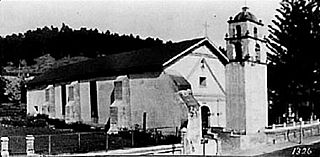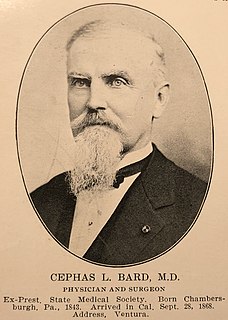
California State University Channel Islands is a public university in Ventura County, California. It opened in 2002 as the 23rd campus in the California State University system. CSUCI is located midway between Santa Barbara and Los Angeles near Camarillo, at the intersection of the Oxnard Plain and northernmost edge of the Santa Monica Mountains range. The Channel Islands are nearby where the university operates a scientific research station on Santa Rosa Island.
Montalvo was an unincorporated village in Ventura County, California, founded in approximately 1887. It was incorporated into the city of Ventura, California, in 2012. Montalvo is located in the southern portion of the city of Ventura, on the northern bank of the Santa Clara River. It is bounded by Victoria Avenue to the west, Ralston Street to the north, Johnson Drive to the east, and the Ventura Freeway to the south.

The Texas School Book Depository, now known as the Dallas County Administration Building, is a seven-floor building facing Dealey Plaza in Dallas, Texas. The building was Lee Harvey Oswald's vantage point during the assassination of United States President John F. Kennedy on November 22, 1963. The Warren Commission concluded that Oswald, an employee at the depository, shot and mortally wounded President Kennedy from a sixth floor window on the building's southeastern corner; Kennedy died at Parkland Memorial Hospital.

Thomas Robert Bard was a political leader in California who assisted in the organization of Ventura County and represented the state in the United States Senate from 1900 to 1905 as a Republican. He is known as the "Father of Port Hueneme" for his efforts in building and expanding the city, as well as the first and only deep water port in the area. He is one of the founders of the UNOCAL company.

The Ventura County Courthouse, known since 1974 as Ventura City Hall, is a historic building in Ventura, California. It is located on a hill at the top of California Street, overlooking the city's downtown district with views of the Santa Barbara Channel and Channel Islands. It was the first building in the City of Ventura to be listed on the National Register of Historic Places and has also received historic designations at the state, county and city levels.

Wagon Wheel is a densely populated, planned neighborhood of Oxnard, California at the intersection of U.S. Route 101 and Oxnard Boulevard. The neighborhood was originally developed as an office, motel, and restaurant complex named Wagon Wheel Junction with a convenient roadside location near the historic community of El Rio. The site in Ventura County became a popular stop for travelers between Los Angeles and Santa Barbara, particularly during its heyday in the 1950s, 1960s and 1970s. The entire site was demolished in 2011 to begin the development of the community with 1,500 residential units.

Oyster Bay is the terminus on the Oyster Bay Branch of the Long Island Rail Road. The station is located off Shore Avenue between Maxwell and Larabee Avenues. It is a sheltered concrete elevated platform that stands in the shadows of the original station, which was accessible from the ends of Maxwell, Audrey, and Hamilton Avenues. Both stations exist along the south side of Roosevelt Park.

The Carnegie Art Museum is a public art museum owned by the City of Oxnard, California in the building originally occupied by the Oxnard Public Library. The Neo-Classical building, located adjacent to Oxnard's Plaza Park, opened in 1907 as the Oxnard Public Library and was converted into an art museum in 1986. In July 1971, it became the first building in Ventura County and the first Carnegie library in California to be listed on the National Register of Historic Places.

Bardsdale United Methodist Church is a historic church located at 1498 Bardsdale Avenue in the unincorporated community of Bardsdale, California, in Ventura County. It is south of the Santa Clara River approximately 3 miles (5 km) from Fillmore.

John Torrey Windrim was an American architect. His long time chief designer was W. R. Morton Keast.
The San Buenaventura Conservancy is an historic preservation organization in Ventura, California also known by its early name of San Buenaventura. It works to recognize and revitalize historic, archeological and cultural resources in the region. The Conservancy is a membership based historic preservation non-profit 501c3 organization. The group was formed in 2004 after the demolition of the Mayfair Theater, an S. Charles Lee, Streamline Moderne, movie theater in downtown Ventura, California that was razed and replaced with a condo project.
The Oxnard Public Library is a free public library system operated by the City of Oxnard, California. It has three locations: the Downtown Main Library, the South Oxnard Branch Library, and the Colonia Branch Library.

The City of Ventura Historic Landmarks and Districts consist of buildings, sites, and neighborhoods designated by the City of Ventura, California, as historic landmarks and districts.

Ortega Adobe is a historic adobe house built in 1857 and located on Main Street on the west side of Ventura, California, not far from the mouth of the Ventura River. It was designated in 1974 as the City of Ventura's Historic Landmark No. 2. It is owned by the City and operated as a self-guided historical site.

A statue in Ventura, California, representing Junípero Serra, the founder of Mission San Buenaventura, was commissioned by Ventura County through the Works Progress Administration as part of the Federal Art Project in 1935. This statue, made of concrete from a clay model by Uno John Palo Kangas, was placed in a prominent location in a public park across the street from the Ventura County Courthouse in 1936. After the Courthouse was repurposed as Ventura City Hall, the statue was designated as City of Ventura Historic Landmark No. 3 in 1974. As deterioration of the concrete statue became a concern, a wood replica was created by local carvers and used to make a bronze cast. The concrete statue was replaced by the bronze cast in 1989. The wood replica was set in the atrium of the city hall for public display.
The Ventura County Historic Landmarks & Points of Interest consist of buildings, sites, and neighborhoods designated by Ventura County Cultural Heritage Board as historic landmarks and points of interest in Ventura County, California. The county board of supervisors created the Cultural Heritage Board in 1966 and in August 1968, two sites were designated: the Faulkner House near Santa Paula; and the Edwards Adobe in Saticoy. The scope was established to include the entire county: both cities and the unincorporated areas. The cities of Fillmore, Oxnard, Port Hueneme, Simi Valley, and Thousand Oaks have the county Cultural Heritage Board advise them and those designations are listed here. The cities of Moorpark, Ojai, Santa Paula, and Ventura established their own separate historic designation systems with the City of Ventura Historic Landmarks and Districts developing into an extensive list. The Port Hueneme Historical Society Museum houses historical artifacts, photographs and information on the history of the Hueneme area. The museum is in the Hueneme Bank Building.

The Serra Cross, sometimes also known as the Cross on the Hill or the Grant Park Cross, is a Christian cross on a hill known as "La Loma de la Cruz" in Ventura, California. The site is in Serra Cross Park, a one-acre parcel within the larger Grant Park that overlooks downtown Ventura, the Santa Barbara Channel, and Anacapa and Santa Cruz Islands.

The Peirano Market, also known as Peirano's Grocery and Peirano Store, is a historic building in Ventura, California. Located across the street from the Mission San Buenaventura, the red brick structure was built in 1877 and has ornamental relief brickwork and a mansard, Spanish revival tile roof.

Eugene Preston Foster, commonly known as E. P. Foster, was a rancher, entrepreneur, banker, and philanthropist in Ventura County, California.

Cephas Little Bard was a doctor and pioneer in Ventura, California, United States. After medical studies in Pennsylvania and service in the American Civil War, Bard moved to Ventura in 1868 and practiced medicine there for more than 30 years. He was also a collector of historical artifacts, a founder of the Ventura County Pioneers, and the leading force behind the construction of the Elizabeth Bard Memorial Hospital.


















